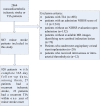Prediction factors of recurrent ischemic events in one year after minor stroke
- PMID: 25774939
- PMCID: PMC4361485
- DOI: 10.1371/journal.pone.0120105
Prediction factors of recurrent ischemic events in one year after minor stroke
Abstract
Background: The risk of a subsequent stroke following a minor stroke is high. However, there are no effective rating scales to predict recurrent stroke following a minor one. Therefore, we assessed the risk factors associated with recurrent ischemic stroke or transient ischemic attack (TIA) within one year of minor stroke onset in order to identify possible risk factors.
Methods: Eight hundred and sixty-three non-cardioembolic ischemic stroke patients in the Chinese IntraCranial AtheroSclerosis Study that presented with minor stroke, defined as an admission National Institutes of Health stroke scale (NIHSS) score of ≤3, were consecutively enrolled in our study. Clinical information and imaging features upon admission, and any recurrent ischemic stroke or TIA within one year was recorded. Cox regression was used to identify risk factors associated with recurrent ischemic stroke or TIA within the year following stroke onset.
Results: A total of 50 patients (6.1%) experienced recurrent ischemic stroke or TIA within one year of minor stroke onset. Multivariate Cox regression model identified lower admission NIHSS score (HR, 1.75; 95% CI, 1.32 to 2.33; P<0.0001), history of coronary heart disease (HR, 2.62; 95% CI, 1.17 to 5.86; P = 0.02), severe stenosis or occlusion of large cerebral artery (HR, 4.68; 95% CI, 1.87 to 11.7; P = 0.001), and multiple acute cerebral infarcts (HR, 2.61; 95% CI, 1.01 to 6.80; P = 0.05) as independent risk factors for recurrent ischemic stroke or TIA within one year.
Conclusions: Some minor stroke patients are at higher risk for recurrent ischemic stroke or TIA. Urgent and intensified therapy may be reasonable in these patients.
Conflict of interest statement
Figures


References
-
- Barber PA, Zhang J, Demchuk AM, Hill MD, Buchan AM. Why are stroke patients excluded from TPA therapy? An analysis of patient eligibility. Neurology. 2001; 56: 1015–1020. - PubMed
-
- Smith EE, Abdullah AR, Petkovska I, Rosenthal E, Koroshetz WJ, Schwamm LH. Poor outcomes in patients who do not receive intravenous tissue plasminogen activator because of mild or improving ischemic stroke. Stroke. 2005; 36: 2497–2499. - PubMed
-
- Johnston SC, Rothwell PM, Nguyen-Huynh MN, Giles MF, Elkins JS, Bernstein AL, et al. Validation and refinement of scores to predict very early stroke risk after transient ischaemic attack. Lancet. 2007; 369: 283–292. - PubMed
-
- Merwick A, Albers GW, Amarenco P, Arsava EM, Ay H, Calvet D, et al. Addition of brain and carotid imaging to the ABCD(2) score to identify patients at early risk of stroke after transient ischaemic attack: a multicentre observational study. Lancet Neurol. 2010; 9: 1060–1069. 10.1016/S1474-4422(10)70240-4 - DOI - PubMed
Publication types
MeSH terms
LinkOut - more resources
Full Text Sources
Other Literature Sources
Medical

